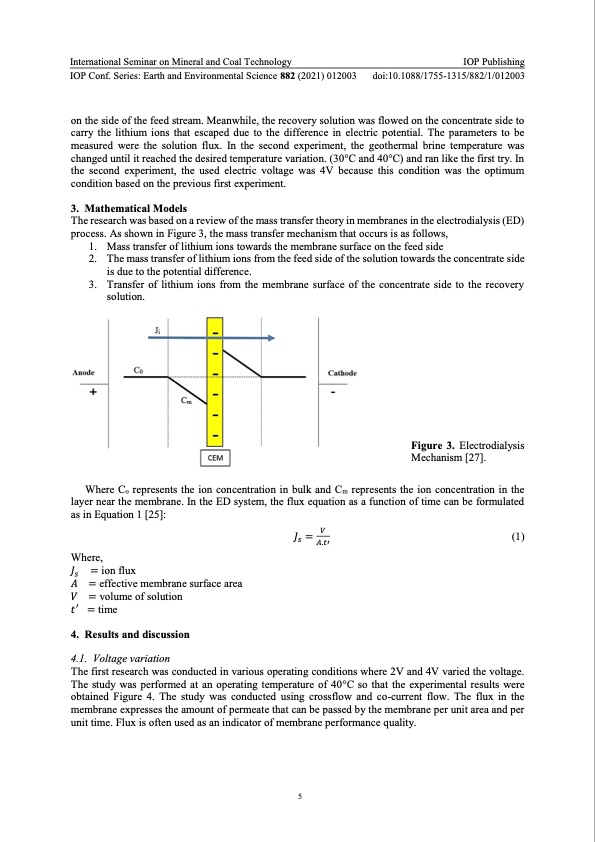
PDF Publication Title:
Text from PDF Page: 006
International Seminar on Mineral and Coal Technology IOP Publishing IOP Conf. Series: Earth and Environmental Science 882 (2021) 012003 doi:10.1088/1755-1315/882/1/012003 on the side of the feed stream. Meanwhile, the recovery solution was flowed on the concentrate side to carry the lithium ions that escaped due to the difference in electric potential. The parameters to be measured were the solution flux. In the second experiment, the geothermal brine temperature was changed until it reached the desired temperature variation. (30°C and 40°C) and ran like the first try. In the second experiment, the used electric voltage was 4V because this condition was the optimum condition based on the previous first experiment. 3. Mathematical Models The research was based on a review of the mass transfer theory in membranes in the electrodialysis (ED) process. As shown in Figure 3, the mass transfer mechanism that occurs is as follows, 1. Mass transfer of lithium ions towards the membrane surface on the feed side 2. The mass transfer of lithium ions from the feed side of the solution towards the concentrate side is due to the potential difference. 3. Transfer of lithium ions from the membrane surface of the concentrate side to the recovery solution. Figure 3. Electrodialysis Mechanism [27]. Where Co represents the ion concentration in bulk and Cm represents the ion concentration in the layer near the membrane. In the ED system, the flux equation as a function of time can be formulated as in Equation 1 [25]: Where, 𝐽𝑠 𝐴 𝑉 𝑡′ = ion flux = effective membrane surface area = volume of solution = time 4. Results and discussion 4.1. Voltage variation 𝐽𝑠 = 𝑉 (1) 𝐴.𝑡′ The first research was conducted in various operating conditions where 2V and 4V varied the voltage. The study was performed at an operating temperature of 40°C so that the experimental results were obtained Figure 4. The study was conducted using crossflow and co-current flow. The flux in the membrane expresses the amount of permeate that can be passed by the membrane per unit area and per unit time. Flux is often used as an indicator of membrane performance quality. 5PDF Image | Lithium recovery synthetic geothermal brine electrodialysis

PDF Search Title:
Lithium recovery synthetic geothermal brine electrodialysisOriginal File Name Searched:
lithium-from-brine-geothermal.pdfDIY PDF Search: Google It | Yahoo | Bing
Product and Development Focus for Infinity Turbine
ORC Waste Heat Turbine and ORC System Build Plans: All turbine plans are $10,000 each. This allows you to build a system and then consider licensing for production after you have completed and tested a unit.Redox Flow Battery Technology: With the advent of the new USA tax credits for producing and selling batteries ($35/kW) we are focussing on a simple flow battery using shipping containers as the modular electrolyte storage units with tax credits up to $140,000 per system. Our main focus is on the salt battery. This battery can be used for both thermal and electrical storage applications. We call it the Cogeneration Battery or Cogen Battery. One project is converting salt (brine) based water conditioners to simultaneously produce power. In addition, there are many opportunities to extract Lithium from brine (salt lakes, groundwater, and producer water).Salt water or brine are huge sources for lithium. Most of the worlds lithium is acquired from a brine source. It's even in seawater in a low concentration. Brine is also a byproduct of huge powerplants, which can now use that as an electrolyte and a huge flow battery (which allows storage at the source).We welcome any business and equipment inquiries, as well as licensing our turbines for manufacturing.| CONTACT TEL: 608-238-6001 Email: greg@infinityturbine.com | RSS | AMP |